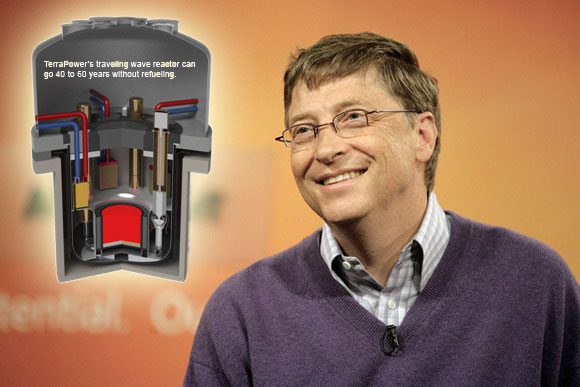The advanced nuclear reactor technology used by Bill Gates’ company is said to be unmatched by Russian technology.
TerraPower, founded by Bill Gates, is seeking permission to build a next-generation nuclear power plant in Wyoming, USA, aiming to promote this technology in Europe, Africa, and Asia, and compete with Russian and Chinese rivals. Will the billionaire’s bold new project succeed?

Bill Gates’ TerraPower develops innovative reactor technology, prioritizing clean energy. (Photo: Slashgear).
According to Sputnik (Russia), TerraPower has entered the global nuclear energy market to compete with Russia and China. The company claims that their sodium-cooled fast reactor, named Natrium, is safer, cheaper, and more energy-efficient than water-cooled power plants.
As part of the small modular reactor (SMR) group, Natrium is said to have the capability to produce 345 megawatts (MW) and can increase to 500 MW in more than five and a half hours if needed.
Obstacles Facing TerraPower
However, according to Alexey Anpilogov, a Russian political scientist and nuclear energy expert, the technology that TerraPower is utilizing is not new. The concept of using sodium-cooled fast reactors with low-enriched uranium-238 as fuel has been thoroughly explored by physicists at the Kurchatov Institute in the Soviet Union since 1958.
Anpilogov told Sputnik: “The TerraPower system uses liquid sodium for cooling [which does not slow down neutron speed], because it is crucial that uranium-238 must have fast neutrons to cause fission. However, this reactor has nuclear safety issues. During the fission of uranium-238 occurring in this reactor, more plutonium-239 is produced, and plutonium-239 is the best raw material for producing nuclear weapons.”

Illustration of TerraPower’s reactor.
It remains unclear what will happen to the plutonium generated from the nuclear reaction, especially if Bill Gates’ company provides this technology to third countries.
Expert Anpilogov notes that the issue of nuclear proliferation has haunted TerraPower for quite some time. He stated: “Although TerraPower was established in 2008, nearly 16 years ago, it still has not received some necessary permits to build a pilot testing facility. I believe that the issue of nuclear security, specifically the Treaty on the Non-Proliferation of Nuclear Weapons, will be a ‘sword’ hanging over Bill Gates’ project.”
Scientist Anpilogov pointed out that while the Soviet Union—and later the Russian Federation—mastered the production and operation of sodium-cooled fast reactors, similar projects in Japan and France have ultimately been shut down.
“Despite having a good engineering school and generally high technology production levels, the projects in France and Japan turned out to be unreliable. Meanwhile, Russia has developed a proven operational technology. Bill Gates has a great idea. But this idea still needs to be realized to achieve stability in all parameters,” Anpilogov said.
According to the Financial Times, TerraPower and other American energy companies are trying to catch up with their competitors in Russia and China, who are exploiting small, cost-effective SMR reactors in Pevek and Shidao Bay.

Bill Gates’ nuclear power plant in Kemmerer, Wyoming.
The Russian floating nuclear power plant (FNPP) in Pevek is equipped with two KLT-40S pressurized water nuclear reactors, while China uses high-temperature gas-cooled reactors (HTGR) to power the Shidao Bay Nuclear Power Plant.
Expert Anpilogov noted that when it comes to sodium-cooled fast reactors, this technology has been used in high-capacity nuclear devices in the Russian BN series.
He pointed to the operational BN-800 reactor at Unit 4 Beloyarsk near the town of Zarechny, Sverdlovsk Oblast, Russia. This reactor has a power generation capacity of 880 MW.
“Russia has implemented clear processes for BN-800 regarding how to use its fuel and its by-products because BN-800 also produces plutonium-239 at weapon levels, but it is continuously disposed of with the type of fuel produced,” expert Anpilogov explained. “We have no issues with the U.S. as an external controlling force, or with the IAEA, the officially authorized UN agency overseeing the nuclear non-proliferation regime.”
Conquering the EU Energy Market
According to the Financial Times, TerraPower has received a $2 billion commitment from the U.S. government to build a new nuclear power plant in Kemmerer, Wyoming.
TerraPower CEO Chris Levesque stated that the company will begin construction work in June 2024. The new nuclear power plant is expected to start operations in 2030.
Last December, TerraPower signed an agreement with the Emirates Nuclear Energy Corporation to supply Natrium reactors to the UAE.
“Nuclear energy has excellent commercial properties, but it also has significant geopolitical impacts. You must look at the competition coming from China and Russia, who see Africa, Indonesia, and other places as future markets,” Anpilogov said.
He noted that the U.S. is trying to push Russia and European competitors out of the nuclear fuel market. Washington has forced Europe to abandon the use of Russian nuclear fuel as part of sanction measures.
Additionally, American energy companies are looking to increase their market share in the nuclear reactor construction market at the expense of both Russian and European producers.
Anpilogov remarked that “the nuclear energy industry still harbors high risks, which are not due to nuclear accidents but rather the risks of poorly considered investments.”


















































